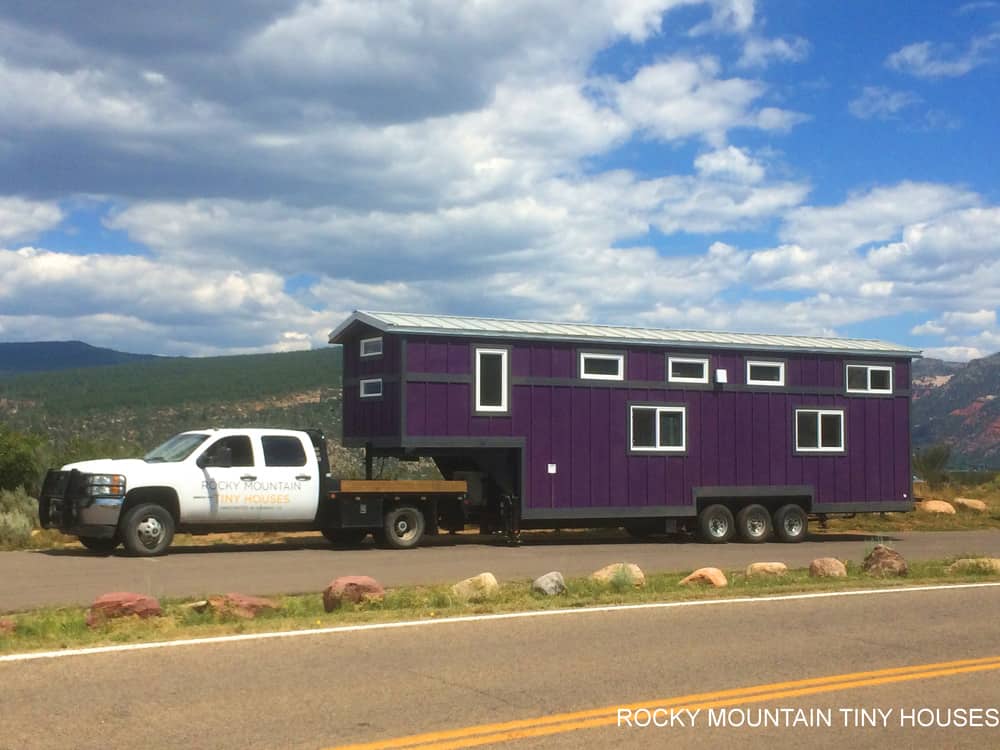Contemplating whether or not to use a gooseneck trailer for your THOW?!
You came to the right spot!
Gooseneck trailers are a popular subject in the tiny house community, and for good reason.
They provide many advantages, included increased stability, better weight distribution, and enhanced maneuverability.
To help you make an informed decision about whether or not to use a gooseneck trailer, I’ve gathered some of the most commonly searched questions.
Gooseneck Trailer Basics
A gooseneck trailer is a type of flatbed trailer with a ‘goose’ neck that extends up into the bed of a truck. It’s similar to a fifth-wheel trailer, but uses a standard ball joint rather than a tractor-trailer style flat hitch.
This offers greater stability and added space over a standard bumper pull trailer.
Why Should I Use a Gooseneck Trailer for a Tiny House?
There are two main benefits to using a gooseneck trailer for a tiny house:
- Towing Stability
- Added Space
A gooseneck trailer is designed to attach to a mount in the bed of your truck rather than a bumper pull hitch. This centers the weight of the tongue over your rear axle instead of your bumper. It makes the load more stable and allows you to take sharper turns.
Space-wise, a gooseneck trailer allows you to actually build on the space above the hitch. This extra space is perfect for storage or as a utility closet for things like propane tanks and water heaters. You can also use it to extend the loft space in your sleeping area.

How Much Headroom is in the Gooseneck Loft of a Tiny Home?
There’s limited headroom above the gooseneck of a trailer. By design it slips over your truck bed door, which makes it several feet taller than the floor of your trailer.
It’s great for use as a storage space or to extend your sleeping loft. The headroom varies wildly depending on the type of build you choose, but in most scenarios, you’ll be able to stand in a loft, or at the very least, sit upright.
How Tall Can I Build a Tiny Home on a Gooseneck Trailer?
Other than the gooseneck itself, this type of trailer is identical to a bumper pull. As a result, you can use standard designs with only slight modifications.
Most people choose to extend their sleeping loft over the gooseneck to give them more space. Others place their utility items like propane storage and water heaters in that area.
What’s the Average Cost of a Gooseneck Trailer?
Gooseneck trailers can be pricey and are always more expensive than the otherwise identical bumper pull trailer. This is because there is more material and several parts you’ll need for your truck to attach to it.
It’s hard to give a firm price estimate because the length of your trailer and it’s trim will significantly affect the cost. For a newly built trailer in a usable size, you’ll be looking at a minimum of $10,000.
As trailer length increases so does that number.
How Much Usable Square Feet Does a 10″ x 40″ Gooseneck Trailer Provide?
The gooseneck portion of a trailer adds an additional 5 feet of space.
You can always build more than that (going up to the edge of your truck’s body), but I prefer to play it safe and leave plenty of room for the body of your tiny home. This allows you to move around near your cab body as you turn.
Overall, you’re looking at 400 feet of ground floor space plus an additional 50 that can go into a loft or storage area.
It’s important to remember, though, that 8.5″ is the legal limit for most US Interstate Highways.
Can I Easily Plumb a Tiny House Bathroom on a Gooseneck Trailer?
Plumbing on a gooseneck tiny house is identical to a regular trailer so long as the bathroom isn’t on the gooseneck.
How Do I Design a Tiny House on a Gooseneck Trailer?
Designing a gooseneck tiny house is pretty much identical to designing a regular tiny home. You can find existing plans that will work on a gooseneck or create your own.
Just remember to take the additional space the gooseneck provides into account.
How Do I Choose the Right Size Gooseneck Trailer for a Tiny House?
Figure out how much space you want for your tiny home and then find the trailer that matches. Remember that the width shouldn’t exceed 8.5’ if you plan to travel in your tiny home.
The gooseneck itself adds about 42.5 additional feet of loft/storage space.
Do I need to Counterweight a Gooseneck Trailer Tiny House?
Balancing the weight of your tiny home on a trailer is always important. Gooseneck trailers don’t require any additional consideration past what a normal tiny home would need.
Do I Lose Ceiling Height When Building a Tiny House on a Gooseneck Trailer?
No. Gooseneck trailers are available with the same deck heights as other trailers. There are even drop axle gooseneck trailers available.
Are There YouTube Videos of Gooseneck Trailer Tiny Homes I Can Check Out?
Tons.
Some of my favorites include:
- The Montana House from Nelson Tiny Houses
2. This awesome gooseneck tiny house trailer from Liberation Tiny Homes
3. The 36’ Wansley Custom Gooseneck Tiny House
How Tall Are Gooseneck Tiny Homes?
Gooseneck tiny homes need to meet the same maximum height as other tiny homes. If you plan to go on the US Interstate Highway System, that maximum is 13.5 ft tall.
Where Can I Buy A Gooseneck Tiny House?
There are tons of companies selling gooseneck trailers. One of my favorites is Big Tex Trailers, and I can’t recommend them enough.

You can also purchase used gooseneck trailers on sites like Equipment Trader or Commercial Truck Trader.



